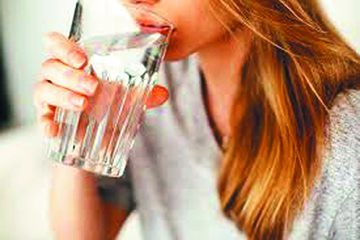By Rosalie Shanks
As the weather gets warmer and more time is spent enjoying the outdoors, staying hydrated is key, especially living at high altitude. Water is an essential part of a healthy diet, in fact, our bodies are made up of about 60% water. It maintains all functions in the body and helps keep your temperature normal. Your body loses water through breathing, sweating, and digestion, so it’s important to rehydrate throughout the day.
Why is staying hydrated so important? Water plays such a key role in our bodies, including the following.
• Keeps temperature normal
• Lubricates and cushions joints
• Gets rid of waste
• Carries nutrients and oxygen to cells
• Protects organs and tissues
• Aids digestion
• Maintains blood pressure
How much water do you really need each day?
It may seem like a simple question, but the answer is quite complicated. Like all nutrition recommendations, it depends on a variety of different factors such as age, weight, height, activity level, and overall health. Women who are pregnant or breastfeeding require more water, the same is true for athletes. Individuals with certain heart conditions and renal disease also have specific fluid needs. The standard recommendation is about 64oz per day. However, for the average healthy adult the National Academy of Medicine recommends:
• Men: 13 cups per day
• Women: 9 glasses per day
• Pregnant women: 10 glasses per day
• Breastfeeding women: 13 cups per day
Hydration Check
How can you tell if you’re getting enough water? The following are signs of dehydration that serve as key warning signals.
• Thirst
• Headaches
• Dry skin
• Fatigue
• Irritability
• Lack of sweat and urination
The easiest way to tell if you are hydrated is to check the color of your urine. A pale-yellow color indicates you are consuming enough fluid. A dark yellow, strong-smelling urine is a sign of dehydration.
It’s important to consume more water after physical activity, in hot weather and when you’re sick, as your body is using it more rapidly.
Tips to increase fluid intake:
• Track your glasses of water/day
• Carry a reusable water bottle around
• Drink from a straw
• Level up your water — add citrus, herbs, fruit
• Alternate morning coffee with a glass of water
• Download a water tracking app on your phone
Other Sources Of Water
Don’t just drink your water, eat it too! While 80% of our fluid comes from beverages, 20% of your daily needs can be met with food. Here are some fruits and veggies that are high in water content:
• Lettuce: 96% water
• Tomatoes: 95% water
• Cucumber: 96% water
• Celery: 95% water
• Watermelon: 91% water
• Strawberries: 91% water
• Cantaloupe: 90% water
• Citrus: 82% water
Level Up Your Drink
If you have trouble getting in plain water, check out this recipe framework to add some flavor without the added sugar! Add of these ingredients to 2 quarts of water and refrigerate for 2 hours.
• 1 lime, 1-pint raspberries
• 4 cups watermelon, 6 sprigs mint
• 1 lemon, 1 lime, 1 orange
• cucumber, 1 cup strawberries
• Steep your favorite tea and pour over ice
• Opt for a sparkling water (make sure there are no added sugars)
Rosalie Shanks is a registered dietitian with experience in health coaching and specializes in weight and diabetes management. She is an advocate for community organizations that promote food access and sustainable food systems.

